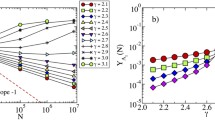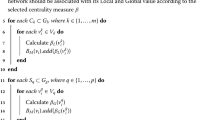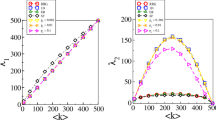Abstract
The spectral properties of the adjacency matrix, in particular its largest eigenvalue and the associated principal eigenvector, dominate many structural and dynamical properties of complex networks. Here we focus on the localization properties of the principal eigenvector in real networks. We show that in most cases it is either localized on the star defined by the node with largest degree (hub) and its nearest neighbors, or on the densely connected subgraph defined by the maximum K-core in a K-core decomposition. The localization of the principal eigenvector is often strongly correlated with the value of the largest eigenvalue, which is given by the local eigenvalue of the corresponding localization subgraph, but different scenarios sometimes occur. We additionally show that simple targeted immunization strategies for epidemic spreading are extremely sensitive to the actual localization set.






Similar content being viewed by others
References
Barrat, A., Barthélemy, M., Vespignani, A.: Dynamical Processes on Complex Networks. Cambridge University Press, Cambridge (2008)
Brin, S., Page, L.: The anatomy of a large scale hypertextual Web search engine. Comput. Netw. ISDN Syst. 30(1/7), 107–117 (1998). https://doi.org/10.1016/S0169-7552(98)00110-X
Castellano, C., Pastor-Satorras, R.: Thresholds for epidemic spreading in networks. Phys. Rev. Lett. 105, 218,701 (2010). https://doi.org/10.1103/PhysRevLett.105.218701
Castellano, C., Pastor-Satorras, R.: Competing activation mechanisms in epidemics on networks. Sci. Rep. 2, 00,371 (2012)
Castellano, C., Pastor-Satorras, R.: Relating topological determinants of complex networks to their spectral properties: structural and dynamical effects. Phys. Rev. X 7, 041,024 (2017). https://doi.org/10.1103/PhysRevX.7.041024
Catanzaro, M., Boguñá, M., Pastor-Satorras, R.: Generation of uncorrelated random scale-free networks. Phys. Rev. E 71, 027,103 (2005)
Chakrabarti, D., Wang, Y., Wang, C., Leskovec, J., Faloutsos, C.: Epidemic thresholds in real networks. ACM Trans. Inf. Syst. Sec. 10, 13 (2008)
Chung, F., Lu, L., Vu, V.: Spectra of random graphs with given expected degrees. Proc. Natl. Acad. Sci. USA 100, 6313–6318 (2003)
Dorogovtsev, S.N., Goltsev, A.V., Mendes, J.F.F.: k-core organization of complex networks. Phys. Rev. Lett. 96(4), 040,601 (2006). https://doi.org/10.1103/PhysRevLett.96.040601
Ferreira, S.C., Castellano, C., Pastor-Satorras, R.: Epidemic thresholds of the susceptible-infected-susceptible model on networks: a comparison of numerical and theoretical results. Phys. Rev. E 86, 041,125 (2012)
Gantmacher, F.R.: The Theory of Matrices, vol. II. Chelsea Publishing Company, New York (1974)
Goltsev, A.V., Dorogovtsev, S.N., Oliveira, J.G., Mendes, J.F.F.: Localization and spreading of diseases in complex networks. Phys. Rev. Lett. 109, 128,702 (2012). https://doi.org/10.1103/PhysRevLett.109.128702
Golub, G.H., Van Loan, C.F.: Matrix Computations, vol. 3. JHU Press, Baltimore (2012)
Karrer, B., Newman, M.E.J.: Message passing approach for general epidemic models. Phys. Rev. E 82(1), 016,101 (2010). https://doi.org/10.1103/PhysRevE.82.016101
Karrer, B., Newman, M.E.J., Zdeborová, L.: Percolation on sparse networks. Phys. Rev. Lett. 113, 208,702 (2014). https://doi.org/10.1103/PhysRevLett.113.208702
Katz, L.: A new status index derived from sociometric analysis. Psychometrika 18(1), 39–43 (1953). https://doi.org/10.1007/BF02289026
Kinouchi, O., Copelli, M.: Optimal dynamical range of excitable networks at criticality. Nat. Phys. 2(5), 348–351 (2006)
Krzakala, F., Moore, C.: Spectral redemption in clustering sparse networks. Proc. Natl. Acad. Sci. 110(52), 20935–20940 (2013). https://doi.org/10.1073/pnas.1312486110
Martin, T., Zhang, X., Newman, M.E.J.: Localization and centrality in networks. Phys. Rev. E 90, 052,808 (2014)
Milanese, A., Sun, J., Nishikawa, T.: Approximating spectral impact of structural perturbations in large networks. Phys. Rev. E 81, 046,112 (2010). https://doi.org/10.1103/PhysRevE.81.046112
Newman, M.: Networks: An Introduction. Oxford University Press Inc, New York (2010)
Pastor-Satorras, R., Castellano, C.: Distinct types of eigenvector localization in networks. Sci. Rep. 6, 18,847 (2016). https://doi.org/10.1038/srep18847
Pastor-Satorras, R., Castellano, C., Van Mieghem, P., Vespignani, A.: Epidemic processes in complex networks. Rev. Mod. Phys. 87, 925–979 (2015)
Pastor-Satorras, R., Vespignani, A.: Immunization of complex networks. Phys. Rev. E 65(3), 036,104 (2002). https://doi.org/10.1103/PhysRevE.65.036104
Pomerance, A., Ott, E., Girvan, M., Losert, W.: The effect of network topology on the stability of discrete state models of genetic control. Proc. Natl. Acad. Sci. 106(20), 8209–8214 (2009). https://doi.org/10.1073/pnas.0900142106
Restrepo, J.G., Ott, E., Hunt, B.R.: Onset of synchronization in large networks of coupled oscillators. Phys. Rev. E 71, 036,151 (2005). https://doi.org/10.1103/PhysRevE.71.036151
Restrepo, J.G., Ott, E., Hunt, B.R.: Characterizing the dynamical importance of network nodes and links. Phys. Rev. Lett. 97, 094,102 (2006). https://doi.org/10.1103/PhysRevLett.97.094102
Restrepo, J.G., Ott, E., Hunt, B.R.: Weighted percolation on directed networks. Phys. Rev. Lett. 100, 058,701 (2008). https://doi.org/10.1103/PhysRevLett.100.058701
Seidman, S.B.: Network structure and minimum degree. Soc. Netw. 5, 269–287 (1983). https://doi.org/10.1016/0378-8733(83)90028-X
Van Mieghem, P.: Graph Spectra for Complex Networks. Cambridge University Press, Cambridge (2011)
Van Mieghem, P., Stevanović, D., Kuipers, F., Li, C., van de Bovenkamp, R., Liu, D., Wang, H.: Decreasing the spectral radius of a graph by link removals. Phys. Rev. E 84, 016,101 (2011). https://doi.org/10.1103/PhysRevE.84.016101
Van Mieghem, P., Omic, J., Kooij, R.E.: Virus spread in networks. IEEE/ACM Trans. Netw. 17(1), 1–14 (2009)
Wang, Y., Chakrabarti, D., Wang, C., Faloutsos, C.: Epidemic spreading in real networks: an eigenvalue viewpoint. In: 22nd International Symposium on Reliable Distributed Systems (SRDS’03), pp. 25–34. IEEE Computer Society, Los Alamitos, CA, USA (2003)
Wang, Z., Bauch, C.T., Bhattacharyya, S., d’Onofrio, A., Manfredi, P., Perc, M., Perra, N., Salathé, M., Zhao, D.: Statistical physics of vaccination. Phys. Rep. 664(Supplement C), 1–113 (2016). https://doi.org/10.1016/j.physrep.2016.10.006. http://www.sciencedirect.com/science/article/pii/S0370157316303349. Statistical physics of vaccination
Author information
Authors and Affiliations
Corresponding author
Additional information
We acknowledge financial support from the Spanish MINECO, under Projects No. FIS2013-47282-C2-2 and No. FIS2016-76830-C2-1-P. R. P.-S. acknowledges additional financial support from ICREA Academia, funded by the Generalitat de Catalunya.
Appendix
Appendix
In this appendix we present data about the real-world networks considered in the analysis.
Rights and permissions
About this article
Cite this article
Pastor-Satorras, R., Castellano, C. Eigenvector Localization in Real Networks and Its Implications for Epidemic Spreading. J Stat Phys 173, 1110–1123 (2018). https://doi.org/10.1007/s10955-018-1970-8
Received:
Accepted:
Published:
Issue Date:
DOI: https://doi.org/10.1007/s10955-018-1970-8




